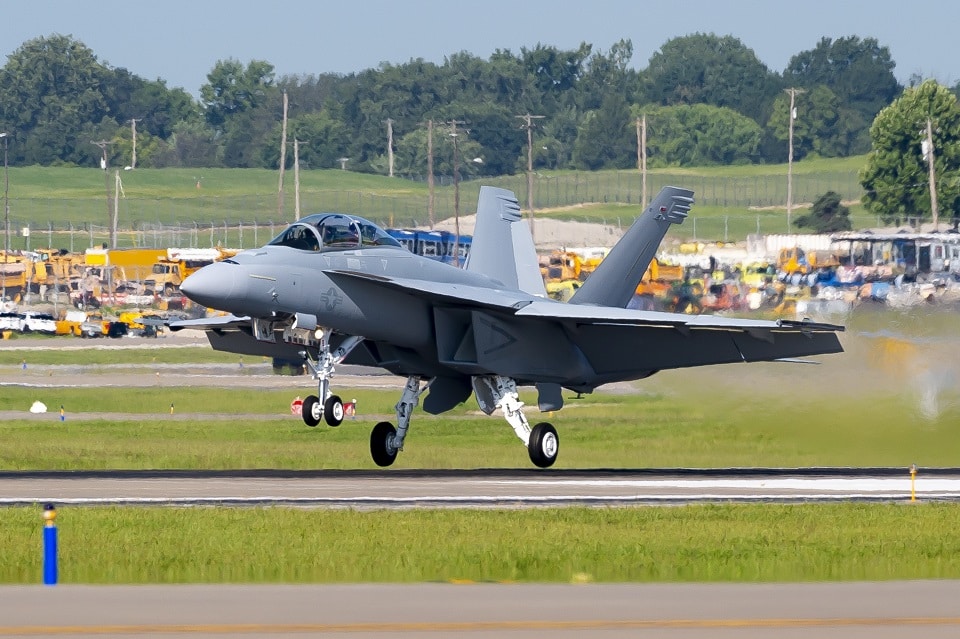Aviation
Boeing, U.S. Navy Demonstrate Manned-Unmanned Teaming with Super Hornet Flight Tests
Boeing Block III F/A-18 Super Hornet successfully demonstrated command and control of three unmanned aerial vehicles for the first time.

ST. LOUIS, 15 JULY 2022 — Boeing [NYSE: BA] and the United States Navy have completed a series of MUM-T flight tests in which a Block III F/A-18 Super Hornet successfully demonstrated command and control of three unmanned aerial vehicles (UAVs).
To collaborate with the UAVs, Boeing system engineers linked Block III’s auxiliary processor, known as the Distributed Targeting Processor – Networked (DTP-N), with a third-party tablet. Boeing created new software loads for the DTP-N that are specifically designed for running the third-party tablet and transmitting commands. In less than six months, the software development, tablet connection to the fighter, and all flying testing were completed.
“Block III Super Hornet is delivering on its promise of hardware that is ready to receive future software,” said Ben LeGrand, Boeing head of Mission Systems. “With modest modifications, Block III Super Hornet will integrate third-party systems and software.”
On the demonstration, Boeing collaborated with the F/A-18 & EA-18G Program Office (PMA-265), Air Test and Evaluation Squadrons (VX) 23 and 31, the Naval Air Warfare Center-Weapons Division at China Lake, Calif., and a third-party vendor. During the test flights, F/A-18 pilots entered commands into the tablet, which were then processed and relayed by the Block III hardware. During two weeks of testing, the UAVs carried out all directions supplied by F/A-18 pilots.
“This successful MUM-T demonstration is an important step toward the Navy’s concept of Distributed Maritime Operations.” It demonstrates the capability of unmanned ideas to broaden and extend the Navy’s reach,” said Scott Dickson, Boeing’s director of Multi-Domain Integration. “As part of a Joint All-Domain Command and Control network, teams of UAVs executing ISR missions commanded by the latest Super Hornets equipped with network-enabled data fusion and enhanced capabilities would provide significant information advantage to warfighters across the Joint Force.”
The F/A-18 is an industry leader in the development and installation of the hardware and computing power required for future digital capabilities and expansion, boasting the largest digital touch screen in any fighter cockpit. The demonstration’s auxiliary processor adds significant computing power to the F/mission A-18’s processing suite.
“Future fighter pilots will be the quarterbacks of the sky, directing directives and controlling unmanned aerial vehicles from the integrated Block III touch-screen cockpit,” said Mark Sears, Boeing vice president and programme manager for the F/A-18 and EA-18G programmes. “The Block III Super Hornet is a bridge to the future and a risk reduction for the Navy, which is already delivering on teaming, networking, and interoperability.”

Aviation
Airbus Enhances A350 Cabin with 10-Abreast Seating

Airbus has announced a new partnership with Jiatai Aircraft Equipment, a Chinese aircraft seating manufacturer, to supply upgraded economy-class seats for the A350 widebody series.
This collaboration, unveiled at the 2024 Airshow China, focuses on developing a newly designed economy seat tailored for the A350‘s New Production Standard (NPS) cabin.
One of the key features of the NPS cabin is the ability to accommodate 17-inch wide economy seats, compared to the previous 16.5-inch wide seats that airlines were limited to in the A350’s earlier configurations.
British Airways Unveils Its Brand-New First Class Cabin for the Airbus A380
This change is made possible by the expanded space in the NPS cabin, which is 35 inches longer and 4 inches wider than the previous version. This extra space is achieved by slightly moving the cockpit wall forward and shifting the rear pressure bulkhead back by one frame.
The wider cabin allows airlines to add up to 30 extra economy seats without compromising comfort. For airlines opting for a 3-4-3 seating layout, the 17-inch wide seats are an excellent choice for a more comfortable passenger experience. However, some airlines, such as Iberia, may choose to retain a 9-abreast layout with wider seats for added comfort.
The NPS cabin also offers enhanced flexibility for airline operators. One major advantage is the ability to easily switch between a 9-abreast and 10-abreast seating configuration without requiring significant downtime for aircraft reconfiguration. Airlines can use the same seat rails, tracks, and IFE interfaces, making the transition smoother and quicker.
Etihad Airways Unveils 10 Exciting New Routes for 2025
In addition, the design of the floor attachments and air-conditioning systems has been optimized for 10-abreast seating, meaning airlines can upgrade their cabins without needing to make substantial modifications to the aircraft’s structure.
Though it’s still unclear when Jiatai’s economy-class seats will be officially added to the A350’s Buyer Furnished Equipment (BFE) catalogue, the collaboration marks a significant step toward enhancing the A350’s cabin offerings.
With this partnership, Airbus is providing more seating options for airlines, ensuring that they can meet diverse customer needs while improving overall operational efficiency.
-

 Aviation2 months ago
Aviation2 months agoMicrosoft Flight Simulator Raises $3 Million to Bring Back the An-225 Mriya
-

 Airlines2 months ago
Airlines2 months agoQatar Citizens Can Travel to the United States Without a Visa
-

 Aviation2 months ago
Aviation2 months agoQatar Airways bans these new Electronic Devices on plane
-

 Airlines2 months ago
Airlines2 months agoJapan Airlines Rolls Out Free Domestic Flights to International Passengers
-

 Travel2 months ago
Travel2 months agoQatar Airways Launches Four Additional Flights from Amsterdam
-

 Defence2 months ago
Defence2 months agoWhich Country Has the Largest Fleet of Fighter Aircraft?
-

 Airport2 months ago
Airport2 months agoWestern Sydney Airport Welcomes Its First Plane After 6 Years of construction
-

 Airlines4 days ago
Airlines4 days agoDAMAC Air: Dubai’s New Luxury Airline Offers Free Flights for Registration








